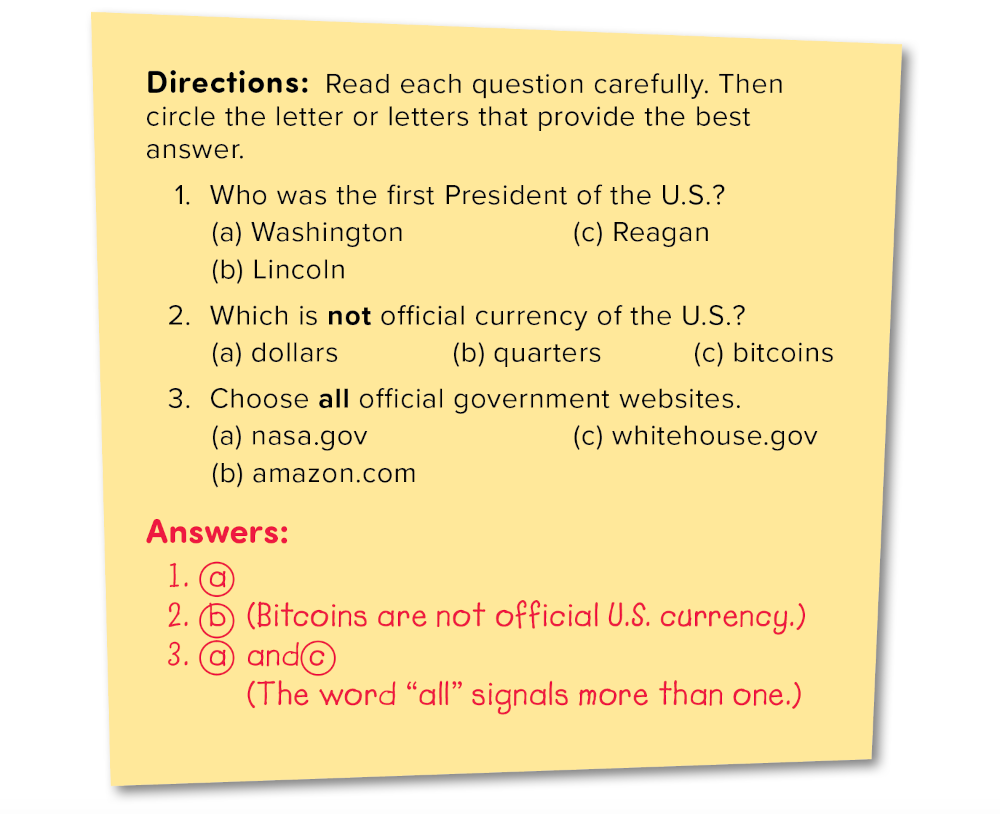WT 310
Page 310
Taking Tests
We’ve all had that bad dream: You arrive in class and find out there’s a test you haven’t studied for. In fact, you haven’t learned any of this stuff! When you wake up from such a bad dream, you breathe a sigh of relief. How do you avoid this situation in real life? You get ready!
Getting Ready
The best way to prepare for a test is to pay attention in class. Do your homework and study beforehand. This chapter helps you be ready for test day and do your best with every type of question.

WT 311
Page 311
Five Smart Things to Do
1. Listen well.
Pay attention in class and do your work. When your teacher talks about a coming test, pay attention to when the test is, what will be covered, and what kind of questions to expect.
2. Gather your materials.
Stuff your backpack with everything you need to study, including your textbook, notes, activity sheets, paper, and something to write with.
3. Plan your study time.
If your test is two days away, study a little each night before the test. Don’t wait until the last minute!
4. Look over everything.
Start with your textbook. Study the chapter headings and words in bold print. Also look over the review questions at the end of the chapter. Then study your notes or activity sheets. (See page 319 for more ideas.)
5. Find a study partner.
Ask a friend to answer study questions from your book or notes. Have the friend drill you, too. You could also ask a family member for help.
WT 312
Page 312
Types of Tests
Tests have different types of questions: true/false, matching, multiple choice, fill in the blank, and writing prompts. (Learn about each type on the following pages.) Ask your teacher what kind of questions to expect on an upcoming test.
True/False Test
On a true/false test, you are given a list of sentences. After reading each sentence, you have to decide if it is true or false.
- If any part of the sentence is false, the answer is false.
- If the whole sentence is true, the answer is true.
- Watch for words like always, never, all, or none. Sentences using these words are usually false.

WT 313
Page 313
Matching Test
On a matching test, you match the words in one column with the definitions in another column.
- Before making any matches, read through both lists.
- Put a mark next to each answer you use. Then it will be easier for you to see which answers you have left.

WT 314
Page 314
Multiple-Choice Test
On a multiple-choice test, you are given different statements or questions with different choices under each one. You select the best choice (or choices) to complete the statement or answer the question.
- Read each statement or question very carefully.
- Look for words like not, never, except, or all. They can change the meaning of the statement.
- Study all of the choices. Then select the best one(s).

WT 315
Page 315
Fill-in-the-Blank Test
On a fill-in-the-blank test, you are given a list of sentences with one or more blanks. You fill in the blanks with words that complete the sentence.
- Count the number of blanks to fill in. The number of blanks usually tells you how many words should be in your answer.
- Ask yourself what information fits into the blank. Does the sentence need a who? a what? a when? or a where?

WT 316
Page 316
Responding to Writing Prompts
On some tests, you respond to a writing prompt.
Tips for Responding to a Narrative Prompt
A narrative prompt asks you to share a true story from your own life. Here’s how to give your best response:
- Study the prompt. What should you write about? How much should you write? Who is your reader?
- Plan your answer. List events in order.
- Write your answer. Start your story. Write what happened in order. Wrap up your story with a last thought.
- Read and revise your response. Check your work.
Jake and I showed up wearing the same shirt.
People made fun of us.
Jake said we were part of a cool club.
Sample narrative prompt: In a paragraph, tell classmates about a funny thing that happened at school.

WT 317
Page 317
Tips for Responding to an Explanatory Prompt
An explanatory prompt asks you to explain a topic in a special way. Here’s how to give your best response:
- Study the prompt. What is your topic? How should you explain it? Who is your audience?
- Plan your answer. List key details
- Read and revise your response. Check your work.
How to Make a Friend
Smile, say “hi,” and give your name.
Ask about the other person.
Tell about yourself.
Find things you both like, and do them together.
Sample explanatory prompt: Write a paragraph explaining to classmates how to make a new friend.

WT 318
Page 318
Tips for Responding to a Persuasive Prompt
A persuasive prompt asks you to give an opinion and reasons for it. Here’s how to give your best response:
- Read the prompt carefully. What is your topic? Who is your reader? How much should you write?
- Plan your answer. Write a clear opinion sentence. Then list reasons to support it.
- Write your answer. Name your topic and share your opinion about it. Give the reasons why your opinion is strong. End by restating your opinion.
- Read and revise your response. Check your work.
Sample persuasive prompt: Write a paragraph to convince classmates to join an activity that you like.

WT 319
Page 319
Remembering for Tests
Use a memory trick.
Memory tricks help you recall information on a test. For example, this sentence helps you spell ARITHMETIC:

You can remember the rainbow colors with ROY G. BIV:

You can remember the Great Lakes with HOMES:

Create flash cards.
Write a question on one side, and the answer on the other. Read the questions and try to answer them. Practice.
Make an idea map.
Map ideas you need to remember. Study your map.
